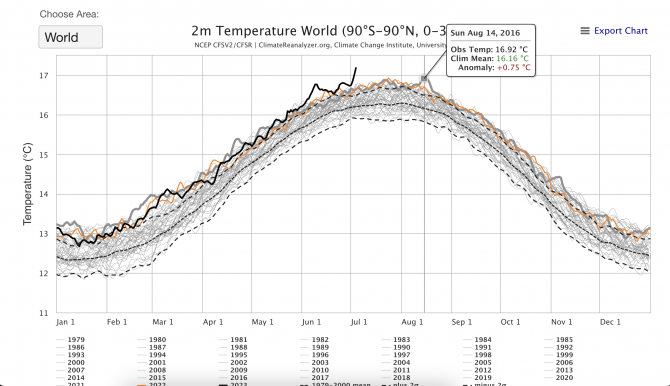
Photo: CliamteAnalyzer.org
On Monday, July 3, Earth’s 62.62 degrees Fahrenheit global average temperature set a new record for the hottest day ever recorded. That record was wiped out and replaced within 24 hours when the global average reached 62.92 degrees Fahrenheit. The data comes from the U.S. National Centers for Environmental Prediction, and these records have only been kept since 1979, but scientists believe the combination of El Niño and climate change trends may have made Tuesday’s record-setter one of the hottest in the past 125,000 years.
Speaking of El Niño, there is also an expectation that the July 4th record won’t last long either thanks to the weather phenomenon that officially kicked off last month. A chart from the National Centers for Environmental Prediction shows that global average temperatures tend to peak later in the month of July. The previous hottest day recorded came during the last El Niño in 2016 and the hottest day(s) didn’t come until mid-August that year (62.46 degrees Fahrenheit).

Photo: climateanalyzer.org
“When’s the hottest day likely to be? It’s going to be when global warming, El Niño and the annual cycle all line up together. Which is the next couple months,” Myles Allen, a professor of geosystem science at Oxford University, told the Washington Post. “It’s a triple whammy.”
Allen also explained that the global average temperatures are already 1.25 degrees Celsius (or 2.25 degrees Fahrenheit) above the preindustrial average, with the overall temperature rising about .25 degrees Celsius per decade. These factors explain why new records seem to be met and set constantly, but we typically see new daily records grow in small increments, like hundredths of a degree. But the jump from the 16.92 degrees Celsius record in 2016 to Tuesday’s 17.18 degrees Celsius anomaly was a pretty big jump.
While 17C and 62F may not sound all that hot, the data collected actually accounts for both daytime and nighttime temperatures all over the world. With half the planet in winter right now and a large chunk of data coming from the poles, we can see how the planet’s global average temperature settles into a pretty moderate range. According to the Climate Analyzer models, it was some of the regions with moderate and even cooler climates that are lifting the overall global averages. North Africa and parts of the Middle East saw the most extreme heat, reaching 122F (50C) recently. But places like Siberia, eastern Canada, and even moderate coastal areas around the world experienced warmer days than usual and contributed heavily to the planet’s high average.
“This record-breaking hottest day is only one of numerous records we will continue to see broken, in light of our continuing rate of greenhouse gas emissions,” said Professor Kathryn Bowen of the University of Melbourne in a statement. “This latest news points to what we already know – that changes in our climate are going to continue to increase and consequent impacts on our health and wellbeing are central to the fallout.”

